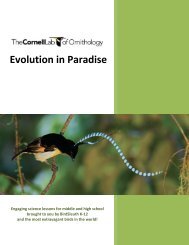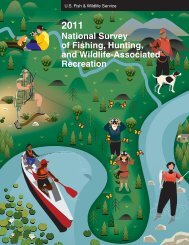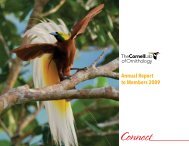BirdScope 11 Autumn 25(4)-For Annetta(2).pdf - All About Birds
BirdScope 11 Autumn 25(4)-For Annetta(2).pdf - All About Birds
BirdScope 11 Autumn 25(4)-For Annetta(2).pdf - All About Birds
Create successful ePaper yourself
Turn your PDF publications into a flip-book with our unique Google optimized e-Paper software.
<strong>BirdScope</strong> Vol. <strong>25</strong> (4) <strong>Autumn</strong> 20<strong>11</strong> 3Focus on studentsFiery FoesAn island’s gulls face downtiny attackersBy Luke DeFisherJust two days after final exams endedin May, I was on a boat headedto Appledore Island, Maine. Startingin mid May, I’d be on that tiny, rockyisland for two months, along with fiveother interns in the Research Internshipin Field Science (RIFS) program atCornell’s Shoals Marine Lab. Gulls weredive-bombing my head, but I had ants onmy mind.Students on Appledore study everythingfrom microbes to seals, but I wasinterested in an uninvited guest, the Europeanfire ant. These ants have beenon Appledore since the 1970s, and theysometimes attack Herring Gull nests,swarming over the chicks and stingingthem. As a budding marine ecologist,I wondered if these individual attackscould take a toll on Appledore’s gull populationas a whole.It wouldn’t be the first time an ant affecteda bird species. The closely relatedred fire ant has hurt Northern Bobwhitepopulations in southeastern Texas, andthe big-headed ant threatens WedgetailedShearwaters in Hawaii. Europeanred ants arrived in New England in 1908,and have been an expensive and growingproblem for New England homeownersever since.I marked out 78 Herring Gull nestsand spent the summer recording thechicks’ daily growth and survival for along-term project run by my adviser, DavidBonter, assistant director of CitizenScience at the Cornell Lab of Ornithology.With two to three chicks to a nest,I had a lot to monitor. I paid extra attentionto 43 of those nests and saw ant attacksat 17 of them. Adult Herring Gullspreened and shook their feathers asthe ants crawled over them. <strong>For</strong> youngchicks the threat was greater, as scoresof shiny, rust-colored ants covered thechicks’ eyes and tiny bills. Amazinglycamouflaged from larger predators, thechicks’ gray-speckled feathers did littleto hide them from six-legged invaders.Most of the chicks survived ant attacks,but four nests—about nine percentof my sample—lost at least one chick.Keep in mind that the 43 nests I studiedwere only a fraction of the HerringGull nests on Appledore that summer.Ants aren’t exactly driving Herring Gullsoff the island—at least 600 pairs nest onAppledore. Still, I’d like to explore themagnitude of this ant-sized problem abit further.On top of fieldwork, I had to adjust toliving on an island for eight weeks. Withonly one well, I became much moreaware of my water and power use. Believeme, when you only get two showersa week and gulls have been making theirexcremental “mark” on you for threedays straight, you learn to make everydrop count. My project really broadenedmy horizons, because I was able to researchtwo radically different kinds ofanimals. Thanks to the opportunity toconduct fieldwork at Shoals, I plan tokeep studying the secret and surprisingdynamics between ants and birds.Luke DeFisher is a junior in the Ecologyand Evolutionary Biology department atCornell University.By Pat Leonard<strong>For</strong> three jam-packed days in August,10 teen birders came to theCornell Lab of Ornithology for ourYoung Birders Event. Each year wegather some of North America’s tophigh-school-age birders here to encouragethem in their hobby and showwhere it might lead. This year’s brightyoung birders came away thrilled withwhat one called a “life-changing” experience.The only downside, said another,was having to spend time sleepinginstead of birding.When they weren’t tackling toughfield identifications, students touredthe Lab, visited the Cornell UniversityMuseum of Vertebrates, and learnedfrom Macaulay Library experts abouthow to record video and sounds ofbirds. Scientists and graduate studentsshared stories of cutting-edge scienceand how they turned their passion forbirds into rewarding careers.By Anne James RosenbergTwo weeks after our Young BirdersEvent (see above), 12 middleschoolers gathered at the Cornell Labof Ornithology for what we like to thinkof as a “Very Young Birders Event.”Wearing borrowed binoculars aroundtheir necks, they watched a Great BlueHeron hunting in a pond, saw its nesthigh in a dead tree, glimpsed a migratingOlive-sided Flycatcher, and heardthe squeaks of a flock of Cedar Waxwingsas they foraged on berries.Officially called EnvironmentalExploration Days, the occasion wasa weeklong camp that allowed theyoungsters to explore local naturalcommunities and empowered themBy Pat LeonardThe Greek goddess ofwisdom is doing herbit to support modern-dayresearch at the Cornell Labof Ornithology. The AthenaFund, established in 2010 byan anonymous donor and recentlyrenewed for 20<strong>11</strong>–12, offers fundingto help graduate students unravelornithological mysteries.In Athena’s first year, seven studentsreceived awards to continue their research.Daniel Baldassarre tramps theAustralian outback to study the breedingbehavior of Red-backed Fairywrens.Caitlin Stern does genetic detective workto learn how often Western Bluebirdsstray from their mates.Nancy Chen studies genetics and diseasein rare Florida Scrub-Jays, and TazaSchaming studies the impact of dwindlingnumbers of whitebark pines onClark’s Nutcrackers in the Greater YellowstoneEcosystem.The Athena Fund made it possible forNate Senner to set up research camps inAlaska and Manitoba, Canada, so he couldrecover Hudsonian Godwits he had taggedwith geolocation tracking devices at thoselocations during previous summers.Stretching Their WingsTeenage birders hone skills, shape futures at Young Birders EventTen sharp young birders honed their skills with eclipse-plumage ducks during one ofthe Young Birders Event field trips.Eric Gulson, 18, of Veracruz, Mexico,arrived not just for the event, butready to start his first semester atCornell, where he joins two previousyear’sparticipants. There’s a methodto our madness—we get first crack attraining future ornithologists and conservationleaders. Gulson is alreadylending his knowledge to our eBirdproject as a work-study student.Sixteen-year-old Sam Brown, ofChickisaw Trail, Oklahoma, said hisGrowing Their Feathers“ultimate ornithological dream” wouldbe to conserve the prairie habitat andbirds of southern Oklahoma. David Weber,17, of Newfield, New Jersey, said “Iexpect birds to be my life in the future.”And we’d like to help. The YoungBirders Event happens every year inAugust. If you know of a promisingyoung birder in grades 9 through 12,tell them about it or contact JessieBarry at jb794@cornell.edu to findout more.to protect these beautiful places. Thecamp was spearheaded by Cornell CooperativeExtension and included educatorsfrom three other local naturecenters.The students traversed the Ithacaarea on day trips, including a boat rideon Cayuga Lake, hikes through Ithaca’sfamous gorges, a visit to the CornellPlantations gardens and arboretum,and a tour of a water-treatment plant.On their visit to the Cornell Lab,the students started with a game of 20questions from our BirdSleuth afterschoolcurriculum: each child had amystery bird taped to his or her back,and they quizzed each other to deducetheir identity. Next they checkedout binoculars and jumped right intolearning the American Goldfinches,Blue Jays, and Northern Cardinals thatgathered at our visitor center birdfeedinggarden.On a walk around our SapsuckerWoods Sanctuary, the students comparedthe woods, shrubby tangles, andwetlands they saw along the trails, andthen took a turn at mapping their ownbackyards in our online YardMap project.At the end of the day, a brainstormingsession about the week’s environmentalissues led to groups of studentsdesigning action plans for each of thetop three issues.New Athena Fund Powers Graduate ResearchTaza Schaming pauses to take notes while studying Clark’s Nutcrackers in Wyoming.In Papua New Guinea, Ben Freemanhopes to understand the restrictedpatterns of bird occurrence in tropicalmountains—and has helped discover sixbird species previously unknown to themountain range where he works.Yula Kapetanakos is investigating thecritical declines of three Asian vulturespecies. Earlier this year she traveled tonorthern Cambodia to collect feathersamples for DNA analysis. “I was invitedto present my work to the CambodianMinistry of Environment,” she said. “Thiswas quite an honor!”The Athena Fund also focuses on students’personal growth during this formativetime in their scientific careers—and plants in them the idea that they mayone day give back to students themselves.Taza Schaming summed it up this way:“I feel very lucky that I have reached aplace in my life where I am able to followmy passion, where I can make importantcontributions to conservation and ecology,and can learn so much every day, whilehaving the opportunity to teach others.”Jessie BarryPocholo Martinez; Owl illustration by Ann-Kathrin Wirth






